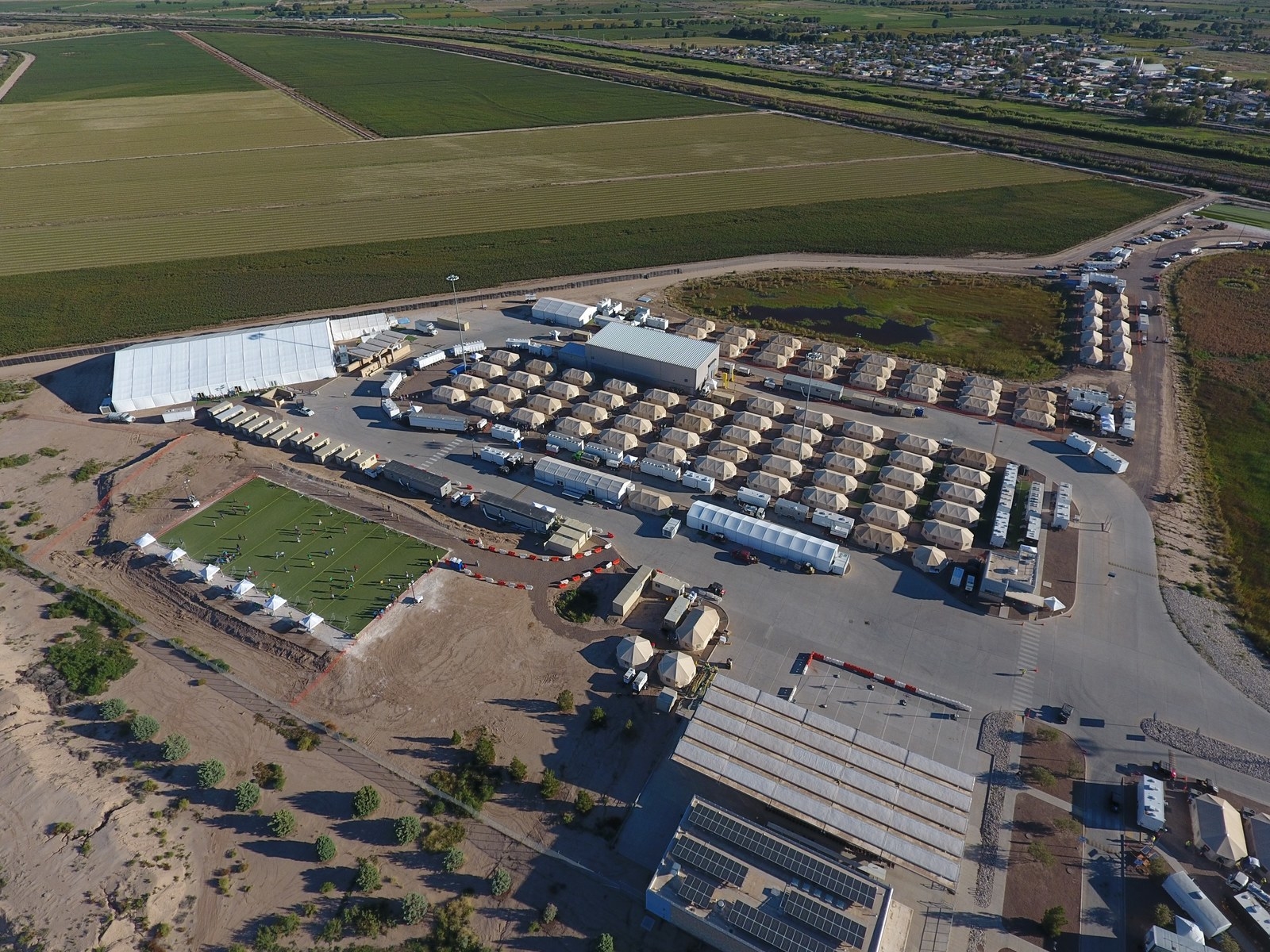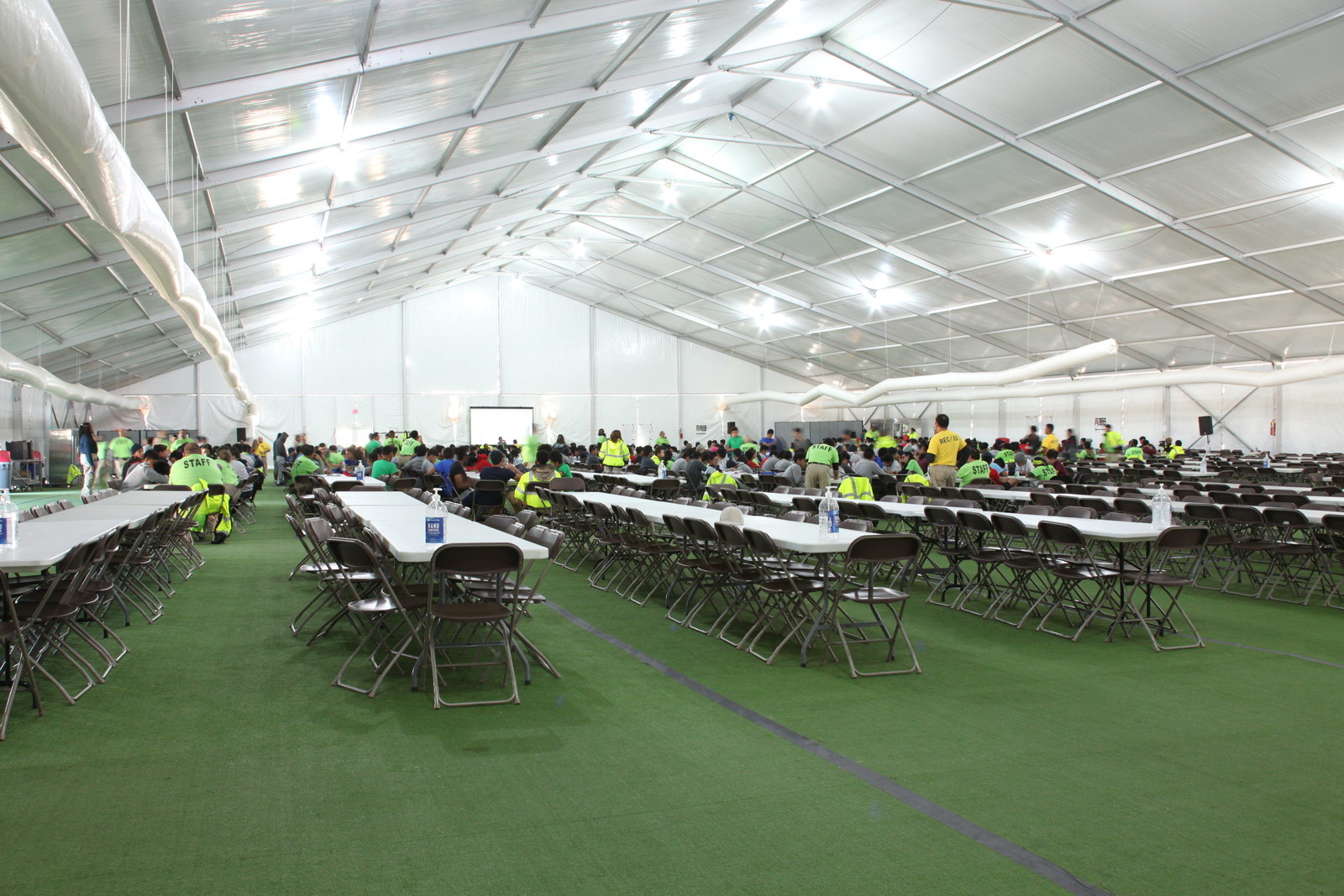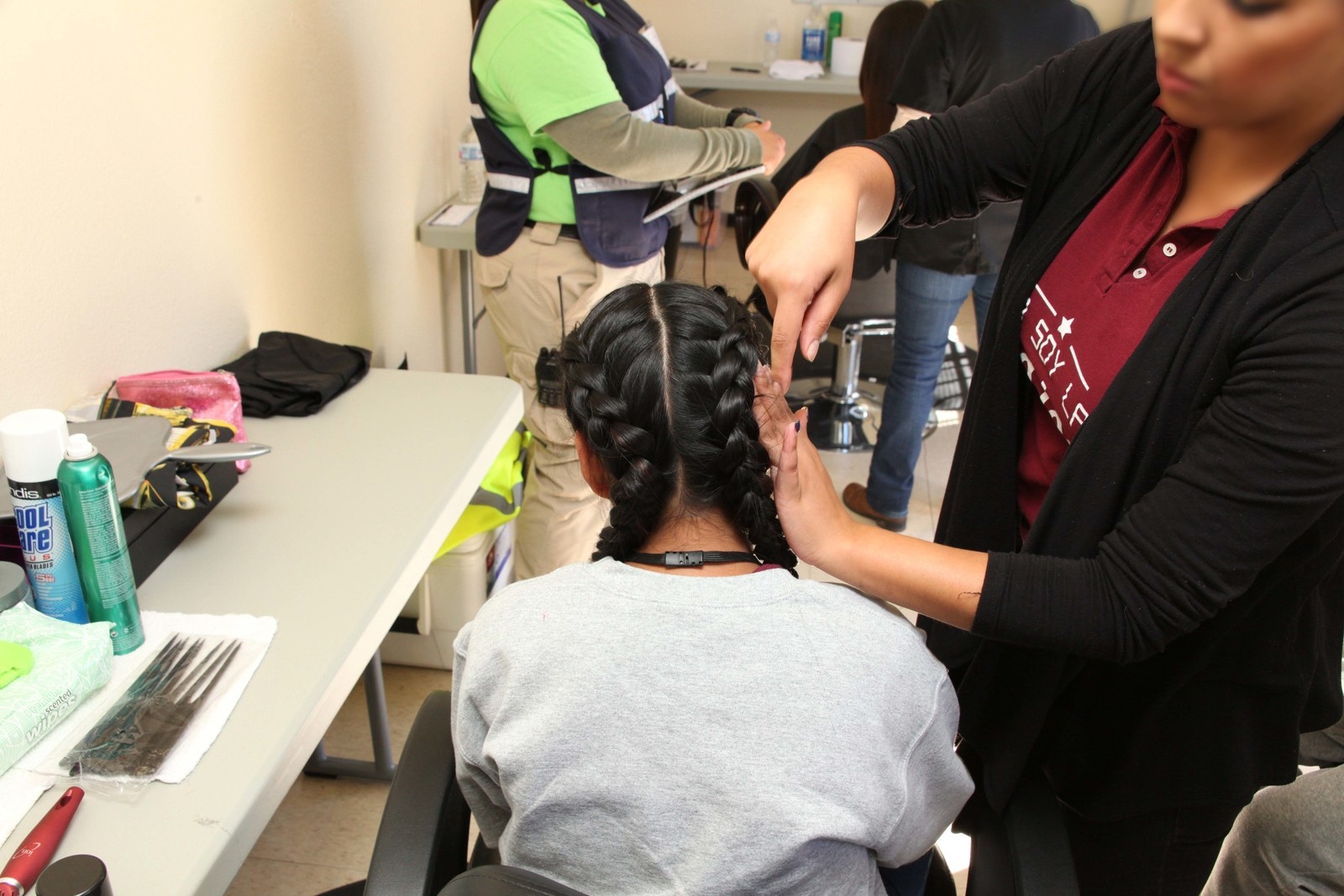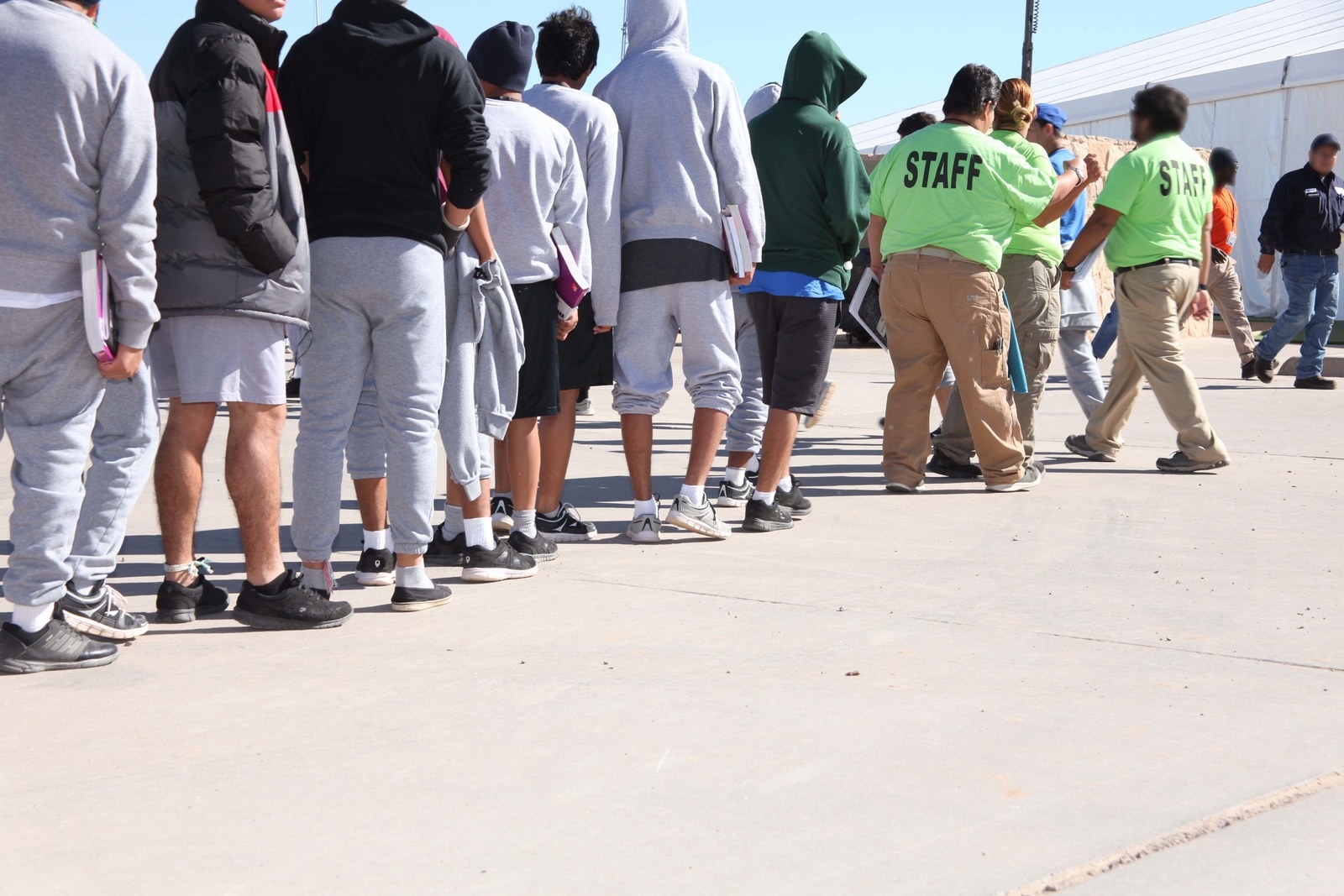http://time.com/5430940/donald-trump-migrant-caravan-false-claims

Katie Reilly reports for Time:
For more than 15 years, nonprofit groups have helped hundreds of asylum-seeking migrants journey through Central America to the United States, traveling together in a caravan to make the journey safer and their plight more visible. Thousands of Central American migrants currently walking to the U.S. border are doing the same, fleeing deadly violence on a trek that has drawn international focus.
As many as 7,000 migrants, according to one local estimate, have now joined the caravan that started on Oct. 13 in Honduras, many wearing flip flops and carrying their children on a journey that will be at least 1,500 miles long, depending on which part of the U.S. border they reach.
President Donald Trump — who has long critiqued U.S. immigration policies and denigrated immigrants since the start of his presidential campaign — has made numerous baseless claims about the caravan in recent weeks, spreading alarm and touting it as a “Great Midterm issue for Republicans!” Trump has claimed, without evidence, that the group included “criminals and unknown Middle Easterners” and falsely suggested that Democrats funded the caravan. He also blamed Democrats for the current immigration laws, though Republicans currently control both chambers of Congress and the White House.
“I have alerted Border Patrol and Military that this is a National Emerg[enc]y,” Trump tweeted early Monday, threatening to cut off foreign aid to Guatemala, Honduras and El Salvador for not “stopping people from leaving their country and coming illegally to the U.S.”
But videos and reporting from journalists traveling with the caravan of migrants show weary families making an arduous journey because of violence or lack of opportunity in their home countries, and no evidence that there are “unknown Middle Easterners” among the group.
“The migrants are ordinary people from Central America. They’re joining the caravans because the migration routes through Mexico are perilous for them and highly expensive,” says Elizabeth Oglesby, an associate professor of Latin American studies at the University of Arizona, who has studied Central America and human rights issues. “The more that the border has become militarized between the U.S. and Mexico, the more perilous and the more expensive the journey has become for Central Americans. So that’s why we see people coming together in the caravans.”
She says the caravan, which is larger than many of its annual predecessors, has grown because of how word spread on social media and because of worsening conditions in Honduras, where the murder rate is among the highest in the world and where the government has cracked down on political protestersfollowing last year’s disputed presidential election.
Oglesby says just a fraction of migrants who begin the trek make it to a U.S. point of entry each year, as many turn back or peel off if they can find work or safety in Mexico instead.
While no specific group has said it’s responsible for organizing the current caravan, Pueblo Sin Fronteras, founded in 2010, has led asylum-seeking migrants through Central America for more than 15 years, most recently in April — another caravan that drew ire from Trump. The group aims to “provide shelter and safety to migrants and refugees in transit, accompany them in their journey, and together demand respect for our human rights.” Some Pueblo Sin Fronteras leaders and organizers are involved in the current caravan.
Trump has lashed out at the caravan as an example of illegal immigration, threatening to deploy U.S. military force to “close our Southern border” and stop what he has described as a crisis. But illegal border crossings have been declining overall for more than a decade, though the number of border apprehensions fluctuates month-to-month. And under U.S. law, it is legal to petition for asylum at the border, though the process may be lengthy and ultimately unsuccessful.
“These migrant caravans are not a border crisis,” Oglesby says. “People are doing this openly and visibly, and they plan to show up at the U.S. port of entry and petition for political asylum, and that is exactly how our laws are supposed to function. The crisis comes about when U.S. border officials discourage people from political asylum, leave them on the bridges or threaten them that if they go forward with a political asylum claim, they might lose their children.”
**************************************************
Katie is hardly the only informed observer to note that Trump is even more full of BS, fabricated facts, and bogus scare techniques than usual on this one.
Here’s Maegan Vasquez over at CNN:
https://www.cnn.com/2018/10/22/politics/donald-trump-migrant-caravan-fact-check/index.html

Washington (CNN)President Donald Trump, in a series of tweets on Monday, claimed he would declare a “national emergency” over an issue that has frequently piqued his attention — migrant caravans moving toward the United States through Central America and Mexico.
His tweets come just weeks ahead of the 2018 midterm elections and he has emphasized immigration as a key issue, without evidence accusing Democrats of pushing for overrun borders in what appears to be a naked fear campaign aimed at turning out his supporters. Immigration was a key issue in the 2016 presidential race.Crowds of migrants, estimated to be in the thousands on Monday, resumed their long journey north on Sunday into Mexico as part of a migrant caravan originating in Central America.Currently migrants are at the Central Park Miguel Hidalgo in the center of Tapachula. Organizers plan for them to begin moving north, reaching the northern city of Huixtla, which is about 20 miles north, and resting there.The President, in his tweets, also made several questionable claims concerning immigration and the caravan. Among them: that “unknown Middle Easterners” are “mixed” in with the caravan, that he would be cutting off foreign aid over the caravan, and that Mexican authorities failed to stop migrants from coming into Mexico.Asked later Monday about his assertion about “unknown Middle Easterners” in the caravan, Trump said: “Unfortunately, they have a lot of everybody in that group.”“We’ve gotta stop them at the border and, unfortunately, you look at the countries, they have not done their job,” he said. “They have not done their job. Guatemala, Honduras, El Salvador — they’re paid a lot of money, every year we give them foreign aid and they did nothing for us, nothing.”Here’s what we know:Are there “unknown Middle Easterners” “mixed” into the migrant caravan?
Trump tweeted “criminals and unknown Middle Easterners are mixed” into the migrant caravan moving toward the United States. He called this a “national emergy” (sic).It’s unclear what “unknown Middle Easterners” Trump appears to be referring to in his tweet, since there have been no reports, in the press or publicly from intelligence agencies, to suggest there are “Middle Easterners” embedded in the caravan.A senior counterterrorism official told CNN’s Jessica Schneider that “while we acknowledge there are vulnerabilities at both our northern and southern border, we do not see any evidence that ISIS or other Sunni terrorist groups are trying to infiltrate the southern US border.”White House press secretary Sarah Sanders said Monday afternoon that the administration “absolutely” has evidence of Middle Easterners in the caravan, “and we know this is a continuing problem.”However, she did not provide the specific evidence supporting that claim.During a White House conference call with surrogates regarding the caravan, a Homeland Security official said the administration is looking into a claim from Guatemalan President Jimmy Morales that his country has been able to capture around 100 terrorists. However, the official did not offer any evidence of the Middle Eastern people who Trump claims are hiding among migrants in the caravan.“We are looking into that claim from the President Morales on the numbers,” Jonathan Hoffman, the DHS official, said. “It is not unusual to see people from Middle Eastern countries or other areas of the world pop up and attempt to cross our borders.”Earlier this month, Morales claimed foreign individuals linked to terrorism were captured in the country during his administration, which began in January 2016.“We have arrested almost 100 people highly linked to terrorist groups, specifically ISIS. We have not only detained them in our territory, they have also been deported to their countries of origin. All of you here have information to that effect,” Morales said during a Conference on Prosperity and Security in Central America event attended by Secretary of State Mike Pompeo.There’s no direct link or correlation between Morales’ statement and Trump’s assertion about the caravan on Twitter.The Department of Homeland Security also did not provide any evidence to bolster the President’s claim about “unknown Middle Easterns” in the caravan when asked for it by CNN on Monday.A department official told CNN that in fiscal year 2018, Customs and Border Protection “apprehended 17,256 criminals, 1,019 gang members, and 3,028 special interest aliens from countries such as Bangladesh, Pakistan, Nigeria and Somalia. Additionally, (Customs and Border Protection) prevented 10 known or suspected terrorists from traveling to or entering the United States every day in fiscal year 2017.”The Department of Homeland Security did not specify any Middle Eastern countries.Pressed about the President’s assertion that there are “unknown Middle Easterners” mixed in with the caravan, a State Department spokesperson said they understand there are several nationalities in the caravan and referred us to Department of Homeland Security for more information.Will the administration cut off foreign aid? Can they?
Trump tweeted that because “Guatemala, Honduras and El Salvador were not able to do the job of stopping people from leaving their country and coming illegally to the U.S.,” the United States “will now begin cutting off, or substantially reducing, the massive foreign aid routinely given to them.”It’s unclear where the administration will propose to make the cuts the President appears to be talking about, and CNN has reached out to the White House and the DHS for further information.However, the Congressional Budget and Impoundment Control Act prohibits the President from withholding — or impounding — money appropriated by Congress.New York Rep. Eliot Engel, the top Democrat on the House Committee on Foreign Affairs, said Monday that his office has reached out to the Government Accountability Office to ensure that the President does not violated the act.“Fortunately, Congress — not the President — has the power of the purse, and my colleagues and I will not stand idly by as this Administration ignores congressional intent,” Engel said in a statement.Trump has made the threat of cuts to foreign aid going to Latin American countries over migrant caravans several times over the last year.Under the Trump administration, and with the approval of the Republican-controlled Congress, there have already been significant cuts to foreign aid to Guatemala, El Salvador and Honduras — the three countries he mentioned Monday — and the administration plans to continue making cuts in fiscal year 2019.Were authorities from Mexico unable to stop the migrant caravan from heading into the US?
Trump tweeted Monday that “Mexico’s Police and Military are unable to stop the Caravan heading to the Southern Border of the United States.”There are some 7,500 people marching north as part of a migrant caravan through Mexico, caravan organizer Dennis Omar Contreras told CNN. He said the organizers did a count of participants Monday morning.He said the migrants will leave Mexico’s Tapachula for the town of Huixtla, which is located more than 20 miles northwest of their Monday morning location.While Mexican authorities said before the caravan’s arrival that anyone who entered the country “in an irregular manner” could be subject to apprehension and deportation, many migrants from the caravan appear to have circumvented authorities.CNN crews witnessed migrants jumping off a bridge at the Mexico-Guatemala border and riding rafts to reach Mexican soil.Mexican authorities say more than 1,000 Central American migrants officially applied for refugee status in Mexico over the past three days.It’s unclear how authorities will respond to the thousands of other migrants who are marching north.Will the President declare a national emergency over the caravan?
It’s unclear exactly what executive action, if any, the President will take following his tweet saying that he has “alerted Border Patrol and Military that this is a National (emergency).”Previous administrations have ordered troops to the US southern border, and Trump issued a similar memorandum earlier this year ordering National Guard troops to be deployed to the US-Mexico border. The memo came around the same time another, smaller migrant caravan was moving toward the US through Central America.Lieutenant Colonel Jamie Davis, a spokesman for the Defense Department, told CNN that “beyond the National Guard soldiers currently supporting the Department of Homeland Security on our southern border, in a Title 32, U.S. Code, section 502(f) duty status under the command and control of the respective State Governors, the Department of Defense has not been tasked to provide additional support at this time.”The Department of Homeland Security, which oversees Customs and Border Protection, referred questions about the national emergency to the White House, which did not answer to several questions for comment.Doris Meissner, a senior fellow at the Migration Policy Institute and the former commissioner of the Immigration and Naturalization Service, told CNN that the President’s use of the term national emergency, and his potential subsequent declaration, is “a subjective judgment.”“It is certainly true that the numbers that have been reported in this group are larger than anything that we’ve seen before this from these countries concentrated in one group,” she said.However, she added that the reaction is “disproportionate to what’s happening.”“I’m not saying it’s not a genuine problem, but it’s not like this is organized insurrection, in the way that its been characterized,” she added.CNN’s Catherine Shoichet, Sarah Westwood, Ryan Browne, Jennifer Hansler, Geneva Sands, Dakin Andone, Patrick Oppmann, Natalie Gallón, Kevin Liptak and Jessica Schneider contributed to this report.
********************************************
And, here’s the ever-wonderful Tal from her “new home” over at the SF Chronicle:

Here’s what happens when the migrant caravan arrives at U.S. border
By Tal Kopan
WASHINGTON — President Trump ratcheted up his rhetoric Monday about a caravan of thousands of Central Americans making its way toward the U.S., even as uncertainty grew over what will happen to the migrants if they reach the border.
Trump has seized on the caravan as a key talking point heading into the midterm elections. The president has been pointing to the growing group of migrants as justification for his aggressive immigration proposals.
“Sadly, it looks like Mexico’s Police and Military are unable to stop the Caravan heading to the Southern Border of the United States. Criminals and unknown Middle Easterners are mixed in. I have alerted Border Patrol and Military that this is a National Emergy. Must change laws!” Trump tweeted Monday.
A source familiar with the government’s information on the caravan said there was no evidence Middle Easterners were mixing into it. It’s unclear whether Mexico will allow the group to continue the remaining 1,000-plus miles to the U.S. border without interfering.
More:
***********************************
Actually, contrary to the false narrative put out by Trump, Sessions, Nielsen, and others, our legal system is set up to handle this situation:
- USCIS could move additional Asylum Officers to ports of entry along the Southern border, particularly given the substantial advance notice;
- Arriving migrants could be promptly and fairly screened for “credible fear;”
- Those who pass could be matched with available pro bono lawyers and released to those locations where their lawyers and community support are located, thus insuring a high rate or appearance for asylum hearings in Immigration Court;
- Those who fail credible fear could be returned to their home countries in a humane manner, perhaps working with the UNHCR;
- If the Administration wants these cases to be “prioritized” in a backlogged Immigration Court system, they could remove an equal number of “low priority” older cases from the docket, thus preventing growth in the backlog and largely avoiding “Aimless Docket Reshuffling;”
- The Refugee Act of 1980 could be used to establish a robust program for screening and resettlement of refugees directly from the Northern Triangle, thus both reducing the incentive to make the land journey to apply for asylum and setting a leadership example for other countries in the hemisphere to take additional refugees from the Northern Triangle;
- We could work cooperatively with the UNHCR and other countries to establish shared resettlement programs for those who flee the Northern Triangle and can’t return;
- We could invest more foreign aid in infrastructure, and job creation programs in the Northern Triangle which would deal with the causes of the continuing outward migration.
We do know from experience and observation what won’t work: incarceration, prosecutions, threats, family separation, child abuse, misconstruing asylum law against applicants, tirades directed against sending and transit countries, saying “we don’t want you,” etc.
PWS
10-22-18


































